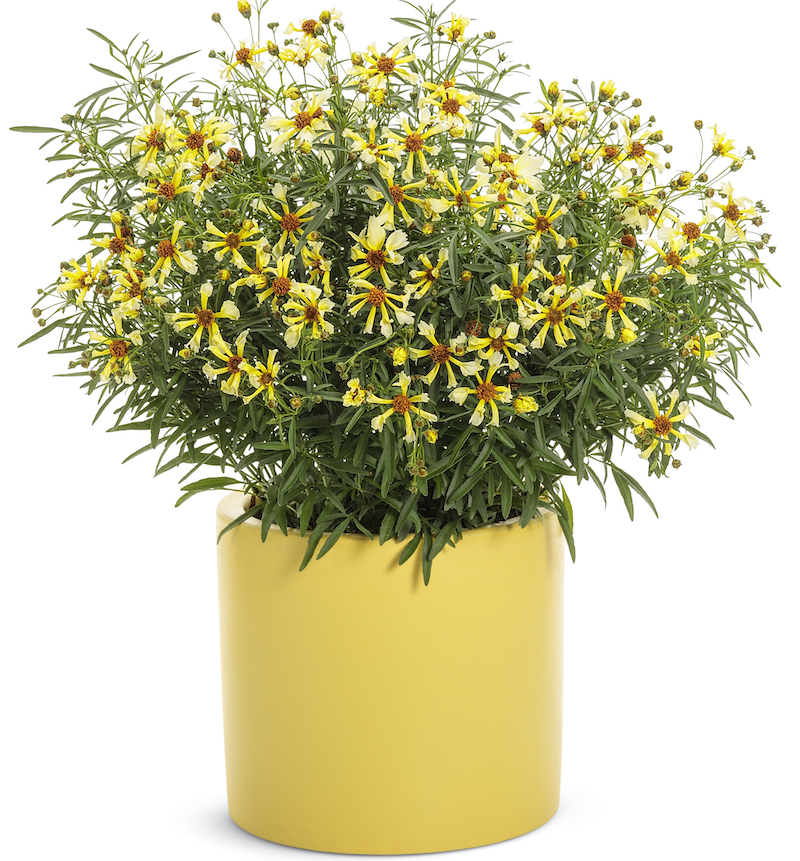Tickseed, or Coreopsis, is native to North America and grows upright groups of flowers that can vary in size and color depending on the species. Gardeners can choose from both perennial and annual varieties in yellow, orange, rose, lavender, white, or multi-colored blooms. These can be planted directly into your garden or grown in a container or hanging basket. If you decide to pot your tickseed, your patio, balcony, or porch could be a great spot to showcase its color. You just need a pot that has drainage holes and enough space to house your tickseed comfortably.

Planting Tickseed in Pots
The best time of year to plant your tickseed is after the risk of frost has passed, but no later than early autumn. Avoid planting during the colder months as these plants need warmer temperatures to thrive. Tickseeds require no less than 6 to 8 hours of direct sun each day, so choose a location that you know can meet those needs.
Although the material of the pot you select isn’t crucial, the size of it is. You need a container that is at least 10 inches in both depth and width. The planter should also have drainage holes that will allow the water to escape from the bottom. This is vital because tickseeds do not tolerate waterlogged soil.

Best Soil For Tickseed in Pots
The best soil type for potted tickseed is all-purpose potting soil. It should be well draining and have a pH level that falls between the range of 5.5 to 6.5. You can also mix in some compost to help balance the density of the soil, which will help the roots of the plant spread out. Furthermore, you can add a light layer of mulch to help with moisture retention, which will help to prevent the soil from drying out.
Caring For Tickseed in Planters
As mentioned above, you can successfully grow tickseeds in hanging baskets. However, caring for them will be slightly different because elevated plants are exposed to wind and dry more quickly. Check moisture levels in hanging baskets frequently. Instead of taking down your basket to check, you can carefully lift the basket from the bottom and if it feels light, the soil is likely dry.
Watering Tickseed in Pots
If you are growing tickseed in a regular pot or container, check the moisture level by inserting your finger into the soil, one or two inches deep. If the soil feels moist, wait to water. If it feels dry, water it deeply. Check every few days. If you want to create a watering routine for your tickseed, we recommend that you water it in the morning, when the water has time to fully absorb into the soil without evaporating. However, if you notice that the soil is dry during any other time of day, feel free to water it. Luckily, tickseeds can tolerate some drought, so don’t panic if the soil is dry. Your tickseed can handle it.
Fertilizing Tickseed in Pots
Potted tickseed will benefit from an annual feeding. The best fertilizer type is a well-balanced granular fertilizer with an NPK ratio of 10-10-10. Using this type of fertilizer will give your plant all of the nutrients it needs to thrive and will also help boost the production of blooms. You can use it once per year, preferably during early spring. Make sure to carefully follow the instructions on the package.
Winter Care For Tickseed in Pots
To prepare your tickseed for winter, add a light layer of mulch during the fall season. You should be watering your plant generously until the ground freezes. During this time, do not try to fertilize your plant as it will be counterproductive. Promoting new growth will not give the plant time to harden off before winter.
Growing Tickseed Indoors
You can bring your plant indoors, but it may be more difficult to care for. Tickseeds need 6 to 8 hours of direct sunlight. So, if you choose to bring your tickseed inside, you need to find a bright window or use grow lights.
 |
Author Chris Link - Published 07-26-2022 |
